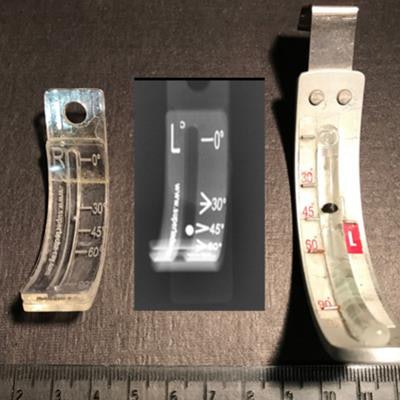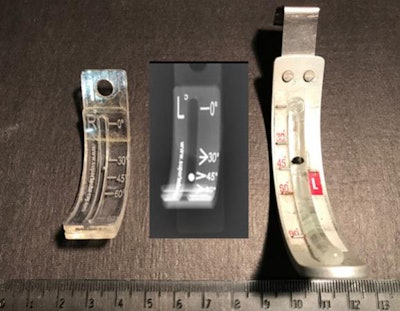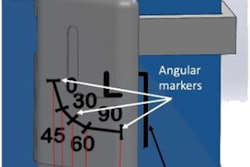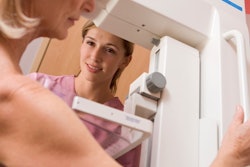
If you build a better mousetrap, the world will beat a path to your door, the saying goes. But what if you design a better x-ray marker? The U.S. National Institutes of Health (NIH) has that in mind as it seeks an industry partner to license UpRite, a new type of chest x-ray marker developed by one of its scientists.
The inspiration for UpRite came to NIH Clinical Center radiologist Dr. Les Folio during one of two tours of duty in Iraq during his career as a radiologist in the U.S. Air Force. Folio wrote the book on combat radiology (literally -- it's called Combat Radiology: Diagnostic Imaging of Blast and Ballistic Injuries), and he was dissatisfied with the markers available at the time for marking the orientation and positioning of patients on chest x-rays.
 The UpRite chest x-ray marker can be made from plastic or metal. Image courtesy of the NIH.
The UpRite chest x-ray marker can be made from plastic or metal. Image courtesy of the NIH.Years later, Folio still sees major shortcomings with the chest x-ray markers used. Many markers only indicate left or right orientation of the patient, ignoring whether the x-ray was acquired with the patient in the upright or supine position. This is particularly an issue for studies acquired with portable x-ray machines, such as when sick patients are imaged while in their hospital beds.
Some markers use BBs in a circular depression to indicate position: the patient is inclined if the BBs are at the bottom and lying flat if the BBs are in the center. But this approach falls short if clinicians want to know the angle at which a patient is inclined, which can be important for diagnosing conditions such as pneumonia or pleural effusion.
Folio's UpRite marker attaches to an x-ray cassette, and it features a ball bearing inside a curved piece marked with a range of degrees, in addition to "L" and "R" markers. Gravity forces the ball bearing to come to rest within the tube at increments of 0°, 30°, 45°, 60°, and 90°, giving clinicians key information about how the patient is positioned. Angles can also be estimated if the ball bearing falls between values.
UpRite can be made of metal or plastic and can even be 3D-printed. During a September 5 NIH webinar, Folio showed a 3D-printed version shaped like a cube printed out of radiolucent material; the ball bearing moves within a curved tube inside the cube.
Folio and co-investigators described UpRite in more detail in a paper published in Radiologic Technology in 2012. In the study, when they tested the marker on 27 portable chest x-ray images, they found that it estimated the correct angle of the cassette and phantom within 10° for all but two of the cases. Commercial markers only indicated if patients were supine or not supine.
The NIH hopes to find an imaging vendor that is interested in commercializing UpRite under license and developing the device further. UpRite was patented as an invention in January 2017 (U.S. Patent No. 9,541,822), valid through 2031.
More information about the marker can be found by clicking here.



















